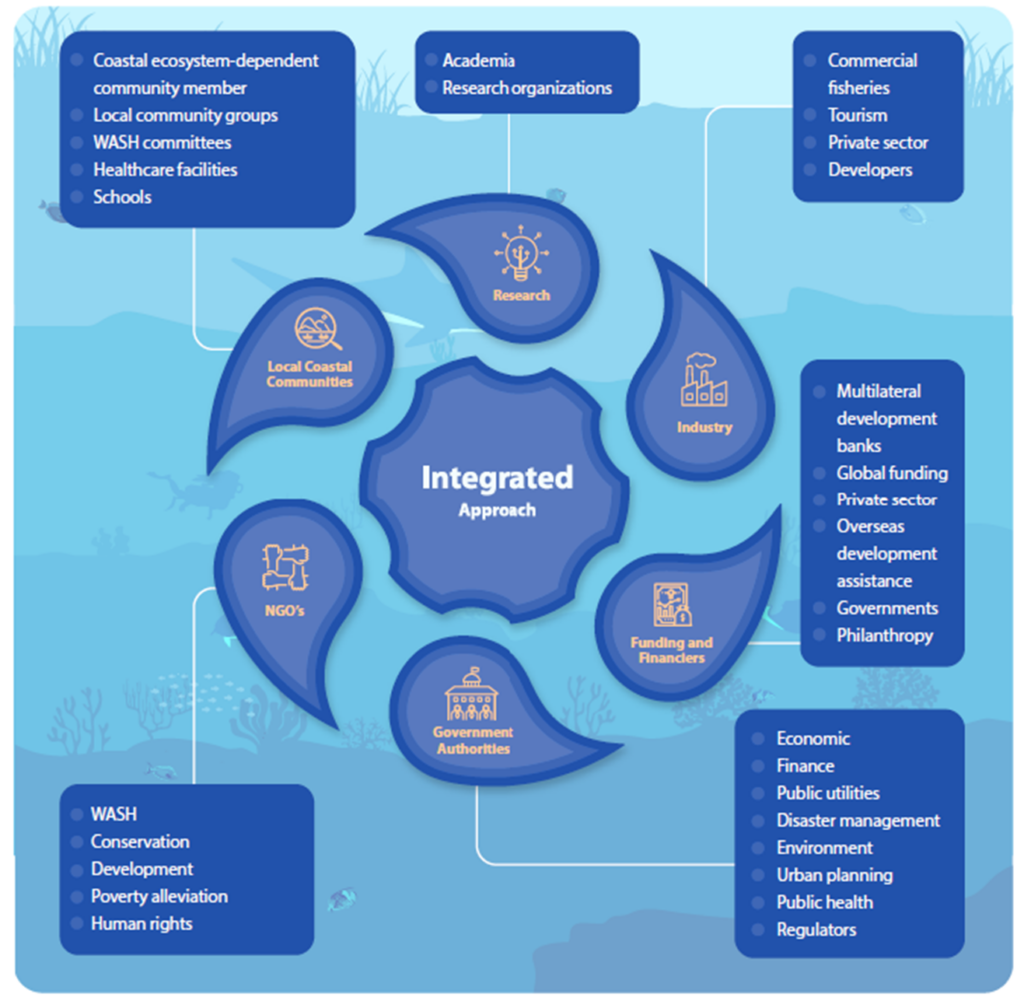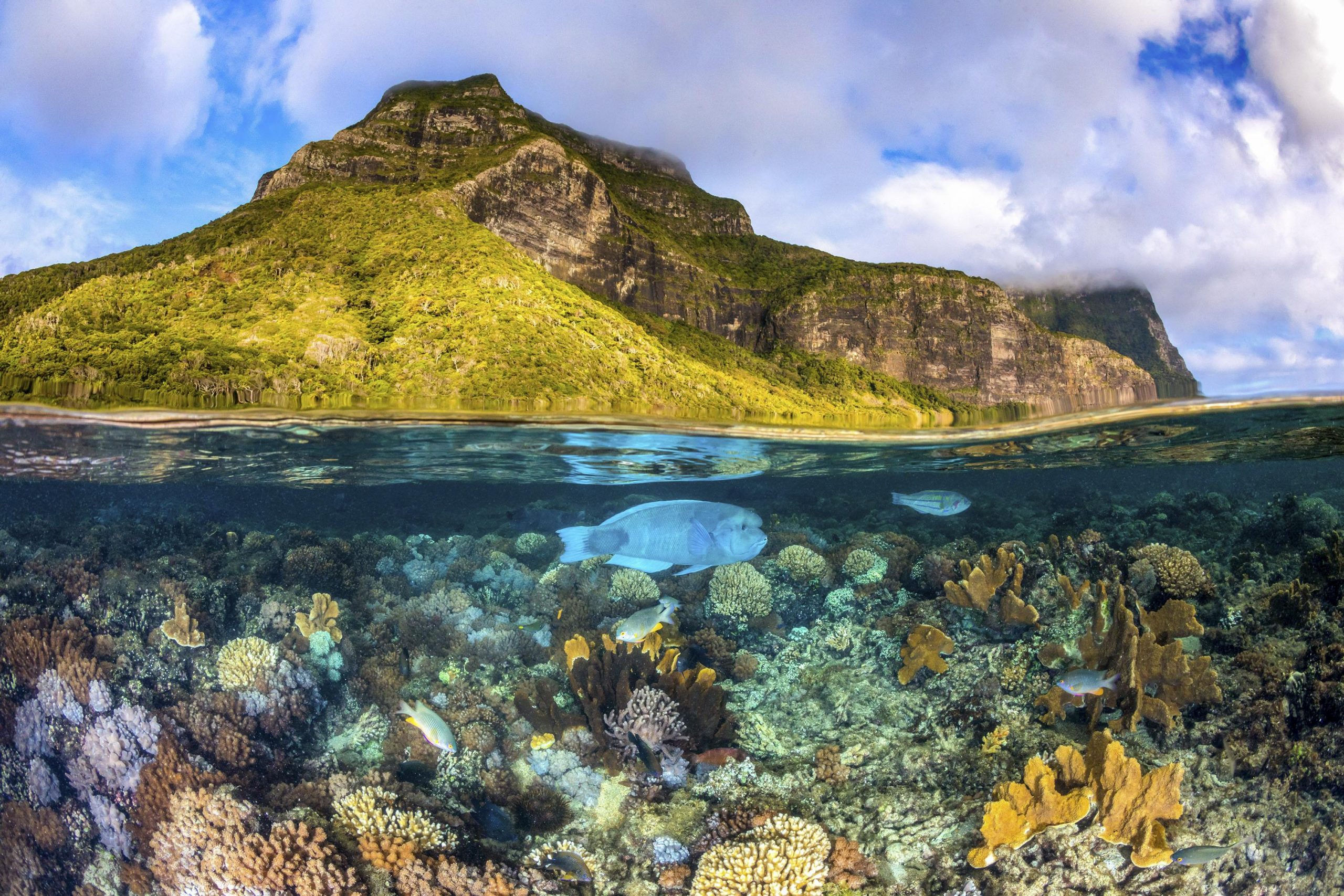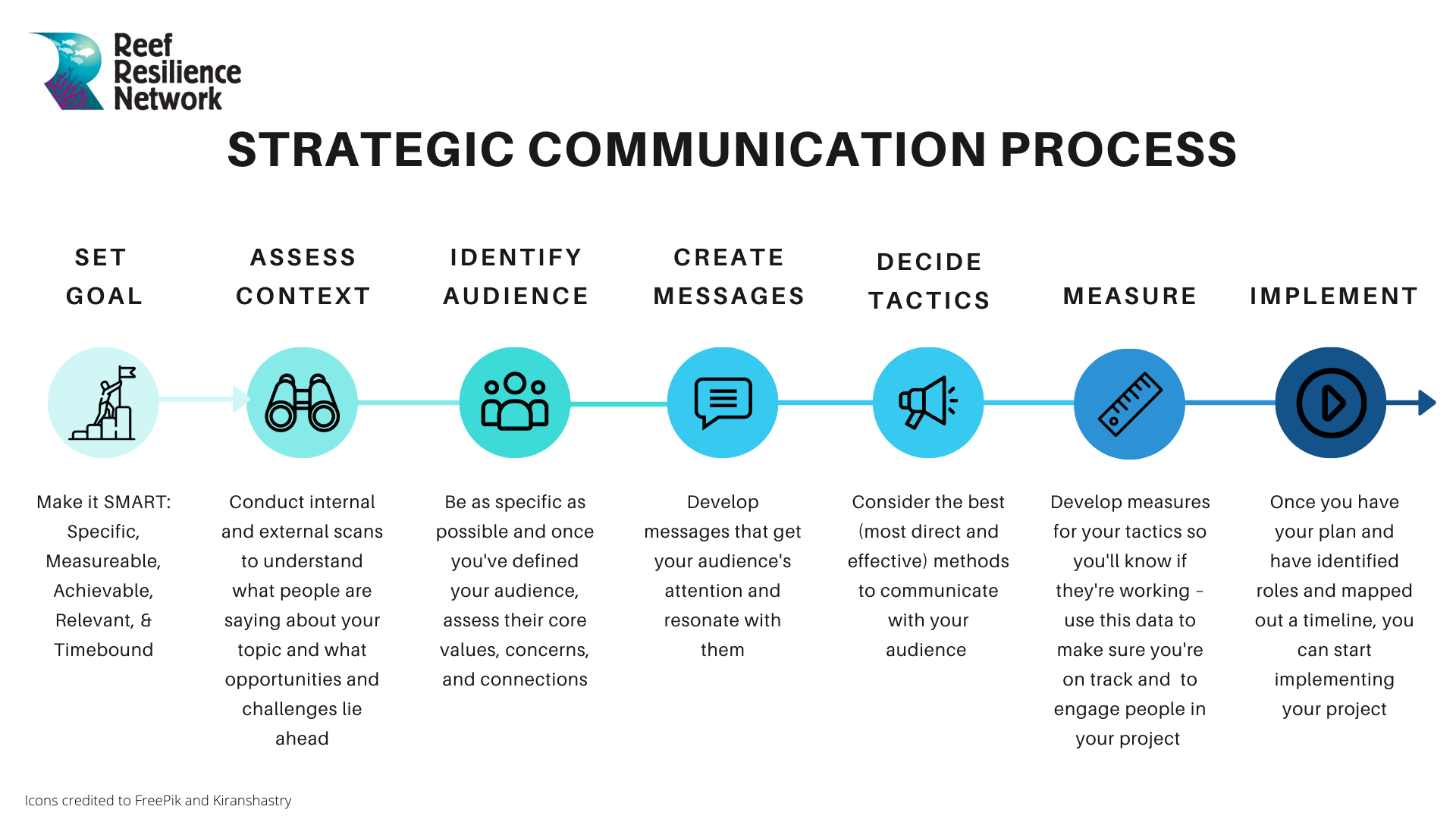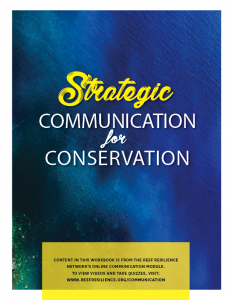Collaboration and Communication
Collaboration
Wastewater pollution is a complex problem, because it crosses multiple landscapes (i.e., ridge to reef) and multiple sectors or disciplines (e.g., public health, environmental, and public works/infrastructure).
Due to the cross-cutting impacts of this pollutant, in order to effectively address it, marine managers need to look beyond their discipline of reef management and collaborate with colleagues in multiple sectors that are typically siloed. These sectors include public health, sanitation, philanthropy, and engineering. Other important partners include managers of coastal lands and adjacent upland areas, tourism boards, utilities, and policymakers.
An integrated approach offers a coordinated and interconnected way to join these sectors to address this complex problem. There are multiple types of stakeholders that could be involved when implementing an integrated approach to wastewater pollution, who each bring different skills to the table. Explore the graphic below to learn about different stakeholder groups that could be involved when implementing integrated conservation and sanitation programs. ref

Different stakeholder groups that could be involved when implementing integrated conservation and sanitation programs. Source: Wenger et al. 2023
Cross-sector collaboration provides a great opportunity to bring new voices and solutions to the forefront, as well as fortify and improve upon solutions that create multiple benefits. ref What cross-sector collaboration “looks like” will depend on a managers’ needs and the local context. Below we have provided information on things to consider when collaborating with a few of these groups: terrestrial resource managers, communities, the WASH sector, policy-makers, and industry.
Partnering with Terrestrial Resource Managers
A ‘ridge-to-reef’ management approach links management action on land with coastal waters for integrated solutions across watersheds and across agencies. Ridge-to-reef projects work to simultaneously improve wastewater management and reduce land-based pollution, thus providing benefits to coral reefs, terrestrial ecosystems, and people. Marine managers could consider how to build relationships with their inland colleagues to partner on wastewater-reducing projects such as increasing permeable surfaces, vegetation, and constructed wetlands that will slow or stop the flow of pollutants into the ocean.

Integrated approaches that link conservation action across watersheds provide benefits to coral reefs. Photo © Jordan Robins/TNC Photo Contest 2019
Engaging Communities in Monitoring and Advocacy
Engaging community members in wastewater monitoring can help them see the problems first-hand and motivate them to serve as champions to communicate findings and build support for solutions. It also provides managers much needed support on-the-ground and can facilitate partnerships with universities, non-governmental organizations, government agencies, and local researchers.
See this case study on the creation of Work 4 Water, a consortium of partners developed to create jobs and address wastewater pollution through the replacement of cesspools in the State of Hawai‘i.
Collaborating with the WASH Sector
Sharing expertise between conservation and Water, Sanitation, and Hygiene (WASH) practitioners is critical to developing sustainable sanitation solutions. WASH initiatives improve people’s access to clean water for drinking and safe disposal of human waste and raise awareness of good hygiene practices to reduce the spread of disease. These initiatives can include a wide variety of projects:
- Education programs in schools and communities
- Donations of soap or water filters
- Partnerships with companies and local workers to build and maintain toilets or latrines
- Collaboration with local governments to establish best practices in dealing with human waste
- Research and learning activities
Because of the WASH sector’s focus on access to safe drinking water and sanitation, their priorities may be focused on immediate needs and solutions as opposed to environmental effects or big picture causes of pollution. However, collaboration between environmental and WASH professionals has the possibility to be mutually beneficial and identify solutions that help both people and nature.
Engaging Policy-makers
Wastewater policies may or may not be a priority, depending on the context. However, creating policies that address public and environmental health is critical to reducing wastewater pollution. When coordinating or developing regulations on wastewater pollution, critical steps include: ref
- Establishing clear mandates and responsibilities for agencies in charge of sanitation, environmental protection, and coordination of the private sector. ref
- Developing capacities within government to lead, formulate, implement, monitor, and evaluate policies across sectors. ref
- Mobilizing sufficient resources for the work based on specific contexts and needs.
- Utilizing high-level coordinating mechanisms such as councils or committees.
- Encouraging formal governance arrangements and informal mechanisms that facilitate communication and collaboration between government authorities and other institutions.
Creating a coordination body specific to wastewater pollution can also be a powerful mechanism to dive deeper into context-specific issues, provide policy advice, and ensure wastewater pollution strategies succeed. Coordination bodies to mitigate wastewater pollution can take on many forms and roles. For example government advisory bodies can ensure policies are aligned and complimentary, engage with stakeholders, develop policy implementation strategies, recommend financing mechanisms, and coordinate activities across government levels. ref
Read the Work-4-Water case study to learn more about a unique consortium of partners recruiting and training a new workforce to install and maintain sewered sanitation systems. This pilot serves as a model for creating training programs for thousands of new workers and will help the State of Hawai‘i make progress towards its goal to replace 88,000 cesspools with sewer systems by 2050.
Working with Industry
Various industries such as commercial, fisheries, tourism, developers, and the private sector can play a role in reducing wastewater pollution. For example, sectors of the tourism industry may have a responsibility to control their own waste such as on a cruise ship or hotel property. Their success is also dependent on good water quality and so they may be eager partners in reducing pollution. Other industries involved in sanitation, utilities, and the surrounding technologies could also have a role to play and see opportunities for new business in waste management.
Communication
Long-standing taboos around human waste pose a particular challenge for communicating about wastewater pollution. Taking time to understand these taboos and what your audience thinks and feels about human waste, elimination practices, and waste management is critical to developing a successful solution and getting support or buy-in from your target audience. For wastewater pollution, investigating the scope of the problem is a great starting point to identify local challenges and establish appropriate goals. Another challenge is engaging the community so they support and/or participate in your sanitation solution. Motivating people to act does not happen quickly. Strategic communication can help address these challenges.
Strategic communication is the purposeful use of communication to achieve a specific goal or outcome. It focuses on delivering the right message to the right person (or audience) at the right time through the right channel to achieve a specific goal.
This approach can help marine managers and practitioners build support, raise awareness, generate funding, strengthen relationships, and influence behavior and public opinion to achieve long-term goals and short-term actions along the way. No matter the need, follow these steps to ensure your communication is targeted, tailored, and timely:

The Strategic Communication for Conservation guide can walk you through this planning process to develop a communication plan to create change for your wastewater pollution issue. It provides communication guidance, examples, and planning worksheets.
For an example of how communication can help mitigate wastewater pollution, explore this case study from Long Island, N.Y., USA where managers used polls and focus groups to develop key messages and determine the best stakeholder communication strategies to tackle nitrogen pollution.
Additional lessons can be learned from behavior change strategies, also known as social marketing or behavior centered design. Explore resources from a recent Behavior Centered Design for Wastewater Pollution workshop the Reef Resilience Network co-hosted with Rare and others to learn more about how you can leverage behavioral insights to change behavior.
Resources
A Guide for Integrated Conservation and Sanitation Programs and Approaches
Strategic Communication for Conservation Guide
Sustainable Sanitation Alliance
Africa Biodiversity Collaborative Group: Freshwater Conservation and WASH
Science for Nature and People Partnership (SNAPP): Water Sanitation and Nature Team

